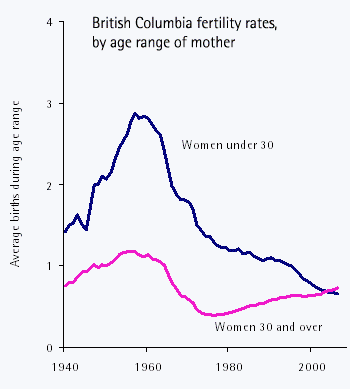Here’s an interesting factoid from north of the 49th parallel: in British Columbia, birth rates for women over 30 recently overtook birth rates for women under 30. Behold, the pink line overtakes the blue!
Historically speaking, this is beyond weird: women under 30 had always been the more fertile demographic group. Always. But no longer. In fact, if current trends continue, births to women over 40 may soon outnumber births to teens. Teen births in the province have fallen an astonishing 89 percent since their baby-boom peak, and are still falling; while births to 40-somethings are steadily rising.
And while I haven’t looked at this more broadly, I’d bet that BC’s fertility patterns are similar to a number of wealthy European nations, and possibly Japan’s as well. The trends are all comparable in the US Northwest, but 20-somethings south of the 49th are still way more fertile than 30-somethings.
I wish I could point to some single explanation for what’s going on here. But it seems to me that it’s just not simple. I mean, there are at least three separate trends involved. Birthrates for women under 30 have fallen steadily for nearly 50 years; birthrates for women over 30 fell from the baby boom peak until the mid-1970s, and have risen steadily since; and birthrates overall fell until 2000, but have roughly stabilized. And all of this has occurred in the context of huge cultural and medical changes: birth control, fertility treatments, rising education and work opportunities for women, yada yada. So the trend lines look clear enough, but the causes…not so clear.
Whatever their source, shifting patterns in fertility are probably more cause for celebration than worry. After all, British Columbia’s women have more control over their own fertility today than at any time in history.
So to a larger extent than in the past, recent changes in fertility have been chosen by women themselves, rather than imposed by outside cultural or economic forces. Hooray!
(If you’re a geek, you can find complete, age-specific fertility data for BC here.)




Dan
This is completely in line with the rest of the planet where increasing wealth and education for women is valued. Now if consumption patterns (and resultant ecological footprint) can be reduced we’d be on to something, as absolute population numbers are increasing and the non-first world birthrates are very high.
MichelleV.P.
Of course, everyone’s circumstances are different, and everyone must make their own choices. But, nearly 20 years ago when I was a married woman and in my mid-twenties , I didn’t want to consider having any children until after I was thirty. Well, thirty came and went, and it was obvious that the marriage was headed that direction, too. So, as a divorced women living through her “loudly ticking-clock thirties,” I lamented about the prospect of being childless for the rest of my life.Now in my 40s, I’ve reconciled with that clock and have instead come to consider it an unexpected blessing to be childfree. Especially in this day and age when women have so many more options for positively making a creative difference in the world.